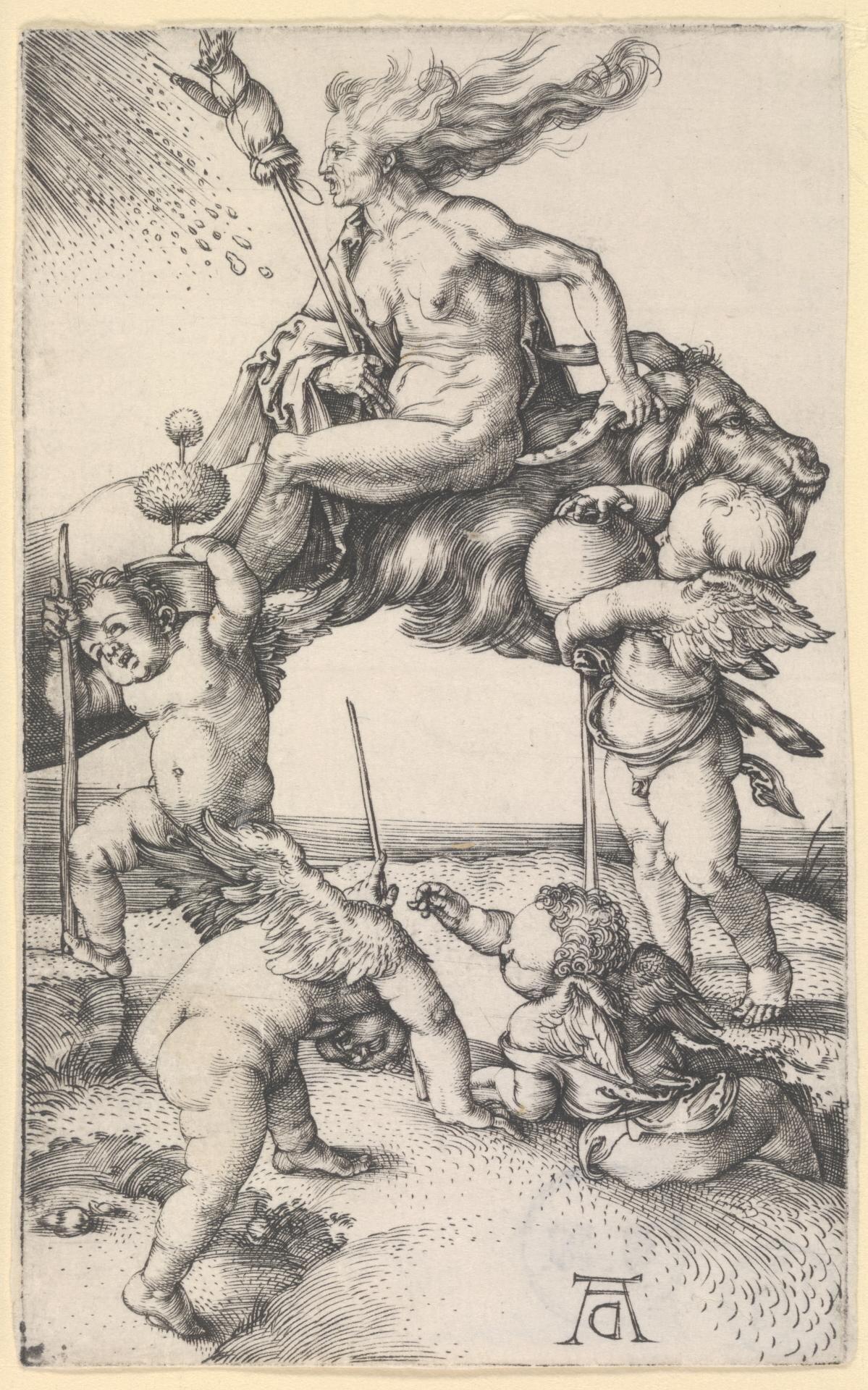Resonance with Evil: Displacement, Physicality, and the Uncanniness of Witchcraft:
Cate Richards’s “Turnips, Like Skulls, Are Heaped House High”
Scholars of historical witchcraft occasionally fall prey to a tendency towards dry recitation of reconstructed facts, interpreting them narrowly within the confines of their particular disciplines—whether history, folklore, sociology, and so on. Especially for scholars who are geographically as well as temporally removed from their objects of study, it is easy to overlook the stark physically of witchcraft, not only in terms of the people involved, but also the ways in which early modern witchcraft beliefs and legends relied on physical, ordinary, quotidian objects—the broomstick being perhaps the most familiar example.
Albrecht Dürer, Witch Riding Backwards On A Goat, 1500
Cate Richards’s artwork in this exhibition, inspired by some of the forms and objects that were indelibly connected to the perception of witchcraft in the period of the witchcraft trials (roughly, 1450 to 1700), helps re-establish the brute physicality of witchcraft as it was experienced and interpreted in the time. Her work accomplishes this in both specific and general ways. For instance, her work Distaffectionate directly recalls an early and hugely significant depiction of witches by Albrecht Dürer, a Nuremberg-based artist who, in about 1507, produced an engraving titled Witch Riding Backwards on a Goat. The eponymous witch, shown naked and (as the title promises) seated backwards upon a goat leaping through the air, clutches the goat’s horn in her left hand and cradles a distaff in the crook of her right arm, in such a posture that interpreting the distaff as anything but an obscene parody of a phallus is impossible. The distaff was hugely symbolic of women and women’s work in the early modern period, and its misuse in this engraving hints at some of the fear surrounding the abilities of women to create, to transform raw material like wool into something new and refined: literally to shape culture. Things like weaving and spinning were women’s work, but also therefore a site of women’s power, and as a result were vulnerable to female witchcraft.
This distaff-like sculpture is also reminiscent of a particular kind of witch’s familiar, known throughout Northern Europe by a variety of names but which typically steals milk from neighboring cows, and sometimes other products of women’s work. Even more evocative of this type of familiar, called a tilberi in Iceland, is the piece Milk-Stealing Harness. Though it can take many forms, the tilberi often resembles a misshaped distaff (or, alternatively, a misshaped phallus), an elongated oblong constructed of grey wool, traditionally wrapped around a dead man’s rib-bone. Powered by the witch’s blood and the Devil’s malice, the tilberi might suck neighboring cows dry before rolling, distended, home to the witch, where it would vomit its stolen milk into her churn.
Like the broomstick, distaffs and butter churns would have been familiar, expected tools in any women’s domicile, rendered uncanny and unsettling in the context of suspicions of witchcraft. Richards’s pieces inspire something like that uncanny feeling—the unease of a physical object that, in some way, for some reason, unsettles one’s sense of the world. The disorder of witchcraft corrupted the strictly ordered world early modern Europeans (of both sexes) sought to construct and maintain, and infected the physical world around them.
In a more general sense, many of the materials Richards works with in her exhibition—rope, wood, iron, textiles—underscore the materiality of witchcraft. Witches were suspected of interfering with daily life, often in concrete and specific ways. The tools they used (like distaffs and cauldrons) were identical to those used all the time. These materials and tools were the stuff of power in the early modern period, and not just the power of women (though the European stereotype of a specifically female witch was established in most places). Both male and female witches might raise storms, cause illness, make cows go dry, and so on—all things that had physical manifestations in peoples’ lived realities. In a real sense, witchcraft in the early modern period was physical, and artwork like Richards’s reminds us of that fact.
Amber Rose Cederström
Ph.D., Scandinavian Studies–Folklore, Department of German, Nordic, and Slavic Studies
University of Wisconsin–Madison

